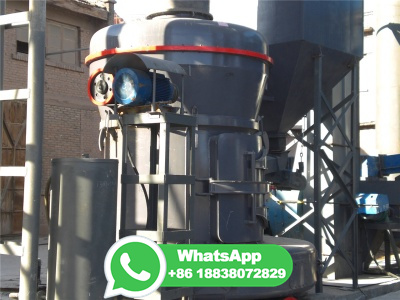How does a coal mill work? LinkedIn
A coal mill works by grinding coal into a fine powder using large metal rollers. This process is used to create precise particle sizes as required by the application. The coal is fed from the ...

A coal mill works by grinding coal into a fine powder using large metal rollers. This process is used to create precise particle sizes as required by the application. The coal is fed from the ...

These "peels" are studied closely by scientists. It's a process that Tom Phillips created and others have developed. To date, U of I researchers throughout the decades have created more than 250,000 coal ball peels. Part of Lakeram's work is digitizing highmagnification images of them. "The point of digitizing the peels is (to ...

Tennessee is the leading producer of ball clay in the nation out of five producing states. Ball clay is used primarily in the manufacture of dinnerware, floor and wall tile, pottery, and sanitary ware. ... Coal production (232,000 short tons) accounted for percent ( million) of Tennessee's total mineral production value in 2018. It ...

Coal balls are petrified pockets of plant debris that were preserved 280 million to 325 million years ago during the Upper Carboniferous Period, sometimes called the Great Coal Age. Plants immortalized in these coal balls are preserved at the cellular level, details not preserved in other types of fossils.

Coal ball is part of WikiProject Geology, an attempt at creating a standardized, informative, comprehensive and easytouse geology resource. If you would like to participate, you can choose to edit this article, or visit the project page for more information.

Coal balls were formed in Carboniferous Period swamps and mires, when peat was prevented from being turned into coal by the high amount of calcite surrounding the peat; the calcite caused it to be turned into stone instead. . What is Coal ball in botany?

A coal ball is a type of concretion, varying in shape from an imperfect sphere to a flatlying, irregular slab. Coal balls were formed in Carboniferous Period swamps and mires, when peat was prevented from being turned into coal by the high amount of calcite surrounding the peat; the calcite caused it to be turned into stone instead.

Director, Maintenance at Warrior Met Coal. Jeff Ball is a Director, Maintenance at Warrior Met Coal based in Brookwood, Alabama. Previously, Jeff was an Assistant SuperintendentMaintenance at CONSOL Energy and also held positions at Buchanan Minerals. Read More. View Contact Info for Free.

A marine origin of coal balls in the Midland and Illinois basins, USA. Coal balls are carbonate concretions that preserve peat in cellular detail. Despite their importance to paleobotany, the salinity of coalball peat remains controversial. Pennsylvanian coal balls..

coal comes from plants, and plants get their energy from the sun, the energy in coal also came from the sun. Th e coal we use today took millions of years to form. We can't make more in a short time. Th at is why coal is called nonrenewable. 300 million years ago Before the dinosaurs, many giant plants died in swamps. 100 million years ago

comparision of tube ball mill it is the most easily and abundantly available, cheap and transportable, energy source types of coal based on proximate analysis of coal on dry basis: pulverised form of coal it has made modern steam generating units highly thermal efficient, reliable and safe.

The ball is coated in a soft polyester material with a small finger loop to keep it from rolling out of your hand. To heat it, place the ball in the microwave for 30 seconds. To cool the stress ball, the brand recommends placing it in the freezer for 30 minutes. Price at time of publication: 6. Key Features

The ball mill trunnion plays a crucial role in the efficient operation of cement mills, autogenous mills, and coal mills. As a key component, the mill trunnion provides support to the mill shell and ensures proper alignment, allowing the mill to function effectively.

Naphthalene is the most abundant single component of coal tar. The composition of coal tar varies with coal type and processing, but typical coal tar is about 10% naphthalene by weight. In industrial practice, distillation of coal tar yields an oil containing about 50% naphthalene, along with twelve other aromatic compounds.

up palaeobotanical coal ball studies and has contributed to the increased output of research. These techniques are well described by Stewart Taylor (I965) and by Phillips et al. (I976). The vast majority of coal ball studies have been undertaken from coal balls collected from coal tips (Andrews Mamay I952).

Coal is a combustible black or brownishblack sedimentary rock with a high amount of carbon and hydrocarbons. Coal is classified as a nonrenewable energy source because it takes millions of years to form. Coal contains the energy stored by plants that lived hundreds of millions of years ago in swampy forests. Layers of dirt and rock covered the ...

Coupa is a cloudbased sourcetopay tool with an easytouse interface that will make it simpler for suppliers to connect with Ball. This new way of working will result in sourcing events, purchase orders, invoices, and communications being managed through the Coupa Supplier Portal. Note: Ball Corporation is deploying Coupa in phases. Please ...

Coal balls tend to be brown in color and the coalball limestone includes many fragments of coal and coal spar. Coal balls are extremely rare in the Eastern Kentucky Coal Field, but are not uncommon in the Springfield (W. Ky. No. 9) and Herrin (W. Ky. No. 11) coal beds in the Western Kentucky Coal Field.

Coal is a sedimentary deposit composed predominantly of carbon that is readily combustible. Coal is black or brownishblack, and has a composition that (including inherent moisture) consists of more than 50 percent by weight and more than 70 percent by volume of carbonaceous material. It is formed from plant remains that have been compacted, hardened, chemically altered, and metamorphosed by ...

Study with Quizlet and memorize flashcards containing terms like Regarding a ball and race pulverizer, how is the upper race kept in contact with the steel balls? Select one: a. by springs b. by the weight of the coal c. by gravity d. by the drive gear, On a natural gas supply system to a boiler, the manual gas shutoff cocks are important for: Select one: a. having fine regulating control of ...

A coal ball is a type of concretion, varying in shape from an imperfect sphere to a flatlying, irregular slab. Coal balls were formed in Carboniferous Period swamps and mires, when peat was prevented from being turned into coal by the high amount of calcite surrounding the peat; the calcite caused it to be turned into stone instead.

A coal ball is a type of concretion, varying in shape from an imperfect sphere to a flatlying, irregular slab. Coal balls were formed in Carboniferous Period swamps and mires, when peat was prevented from being turned into coal by the high amount of calcite surrounding the peat; the calcite caused it to be turned into stone instead.

The coal is fed into the ball mill through a central inlet pipe where gravity is used to lead the coal to the bottom of the mill, where the grinding table and some heavy rollers pulverize the coal to particles. Coal particles are mixed with the hot air, which enters the mill through the air inlet, and are conveyed up to the classifier by the ...

Feliciano (1924) investigated the coalballs of the Illinois basin and concluded that they were formed in situ and that the plant structures were AN EXAMPLE OF THE ORIGIN OF COALBALLS 453 preserved from rapid decay by the peaty acids exuding from the sur rounding coalified material.

Coal mill is also called coal pulverizer or coal grinder. It is a mechanical device used to grind raw coal into pulverized coal powders. The most used coal mills in cement plants are airswept ball mill and vertical roller mill. At present, most cement plants use coal as the main fuel in the clinker production process.

3. pulverizer/mill system One of the critical power plant components that is relied upon to convert the energy stored in coal into electricity is the coal pulverizer or mill. The coal flow is controlled by the feeder, allowing coal to flow into the pulverizer mill. The pulverized coal and air mixture is then transport to the boiler ...

Ball Mills: A ball mill is a cylindrical machine with a horizontal axis, some of which contain grinding media such as steel balls or steel rods. The mill receives coal feed and grinds it by the impact and friction of rolling balls. For grinding coal, ball mills are frequently used in cement factories and coalfired power plants.